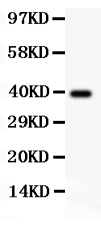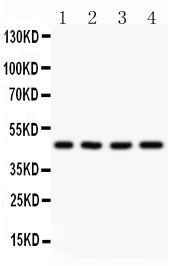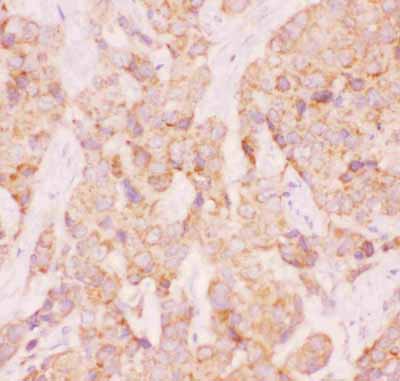Anti-AAMP Picoband Antibody
- SPECIFICATION
- CITATIONS
- PROTOCOLS
- BACKGROUND

Application
| WB, IHC-P |
|---|---|
| Primary Accession | P55774 |
| Host | Rabbit |
| Reactivity | Human |
| Clonality | Polyclonal |
| Format | Lyophilized |
| Description | Rabbit IgG polyclonal antibody for Angio-associated migratory cell protein(AAMP) detection. Tested with WB, IHC-P in Human. |
| Reconstitution | Add 0.2ml of distilled water will yield a concentration of 500ug/ml. |
| Gene ID | 6362 |
|---|---|
| Other Names | C-C motif chemokine 18, Alternative macrophage activation-associated CC chemokine 1, AMAC-1, CC chemokine PARC, Dendritic cell chemokine 1, DC-CK1, Macrophage inflammatory protein 4, MIP-4, Pulmonary and activation-regulated chemokine, Small-inducible cytokine A18, CCL18(1-68), CCL18(3-69), CCL18(4-69), CCL18, AMAC1, DCCK1, MIP4, PARC, SCYA18 |
| Calculated MW | 9849 MW KDa |
| Application Details | Immunohistochemistry(Paraffin-embedded Section), 0.5-1 µg/ml, Human, By Heat Western blot, 0.1-0.5 µg/ml, Human |
| Subcellular Localization | Secreted. |
| Tissue Specificity | Expressed at high levels in lung, lymph nodes, placenta, bone marrow, dendritic cells present in germinal centers and T-cell areas of secondary lymphoid organs and macrophages derived from peripheral blood monocytes. Not expressed by peripheral blood monocytes and a monocyte-to-macrophage differentiation is a prerequisite for expression. Expressed in synovial fluids from patients with rheumatoid and septic arthritis and in ovarian carcinoma ascitic fluid. . |
| Protein Name | Angio-associated migratory cell protein |
| Contents | Each vial contains 5mg BSA, 0.9mg NaCl, 0.2mg Na2HPO4, 0.05mg NaN3. |
| Immunogen | E.coli-derived human AAMP recombinant protein (Position: E235-R434). |
| Purification | Immunogen affinity purified. |
| Cross Reactivity | No cross reactivity with other proteins |
| Storage | At -20˚C for one year. After r˚Constitution, at 4˚C for one month. It˚Can also be aliquotted and stored frozen at -20˚C for a longer time.Avoid repeated freezing and thawing. |
| Sequence Similarities | Contains 8 WD repeats. |
| Name | CCL18 |
|---|---|
| Synonyms | AMAC1, DCCK1, MIP4, PARC, SCYA18 |
| Function | Chemotactic factor that attracts lymphocytes but not monocytes or granulocytes. May be involved in B-cell migration into B- cell follicles in lymph nodes. Attracts naive T-lymphocytes toward dendritic cells and activated macrophages in lymph nodes, has chemotactic activity for naive T-cells, CD4+ and CD8+ T-cells and thus may play a role in both humoral and cell-mediated immunity responses. |
| Cellular Location | Secreted. |
| Tissue Location | Expressed at high levels in lung, lymph nodes, placenta, bone marrow, dendritic cells present in germinal centers and T-cell areas of secondary lymphoid organs and macrophages derived from peripheral blood monocytes. Not expressed by peripheral blood monocytes and a monocyte-to-macrophage differentiation is a prerequisite for expression. Expressed in synovial fluids from patients with rheumatoid and septic arthritis and in ovarian carcinoma ascitic fluid |

Thousands of laboratories across the world have published research that depended on the performance of antibodies from Abcepta to advance their research. Check out links to articles that cite our products in major peer-reviewed journals, organized by research category.
info@abcepta.com, and receive a free "I Love Antibodies" mug.
Provided below are standard protocols that you may find useful for product applications.
Background
AAMP, also known as Angio-associated, migratory cell protein, is a protein which in humans is encoded by the AAMP gene. It is mapped to 2q35. The gene product of AAMP is an immunoglobulin-type protein, which is found to be expressed strongly in endothelial cells, cytotrophoblasts, and poorly differentiated colon adenocarcinoma cells found in lymphatics. It has been demonstrated that an AAMP peptide containing the putative heparan sulfate-binding domain binds to heparin and mediates heparin-sensitive cell adhesion. AAMP plays a role in angiogenesis and cell migration. In smooth muscle cell migration, it may act through the RhoA pathway.
If you have used an Abcepta product and would like to share how it has performed, please click on the "Submit Review" button and provide the requested information. Our staff will examine and post your review and contact you if needed.
If you have any additional inquiries please email technical services at tech@abcepta.com.













 Foundational characteristics of cancer include proliferation, angiogenesis, migration, evasion of apoptosis, and cellular immortality. Find key markers for these cellular processes and antibodies to detect them.
Foundational characteristics of cancer include proliferation, angiogenesis, migration, evasion of apoptosis, and cellular immortality. Find key markers for these cellular processes and antibodies to detect them. The SUMOplot™ Analysis Program predicts and scores sumoylation sites in your protein. SUMOylation is a post-translational modification involved in various cellular processes, such as nuclear-cytosolic transport, transcriptional regulation, apoptosis, protein stability, response to stress, and progression through the cell cycle.
The SUMOplot™ Analysis Program predicts and scores sumoylation sites in your protein. SUMOylation is a post-translational modification involved in various cellular processes, such as nuclear-cytosolic transport, transcriptional regulation, apoptosis, protein stability, response to stress, and progression through the cell cycle. The Autophagy Receptor Motif Plotter predicts and scores autophagy receptor binding sites in your protein. Identifying proteins connected to this pathway is critical to understanding the role of autophagy in physiological as well as pathological processes such as development, differentiation, neurodegenerative diseases, stress, infection, and cancer.
The Autophagy Receptor Motif Plotter predicts and scores autophagy receptor binding sites in your protein. Identifying proteins connected to this pathway is critical to understanding the role of autophagy in physiological as well as pathological processes such as development, differentiation, neurodegenerative diseases, stress, infection, and cancer.




